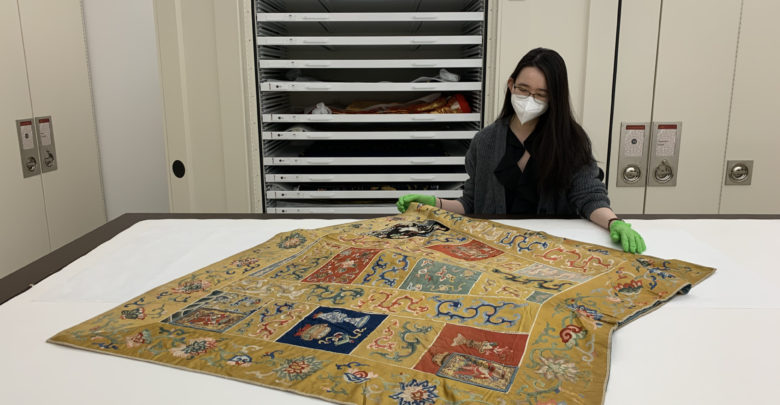Lion, Lantern, Lotus exhibit at the U of A Museums highlights student work and Chinese-Buddhist history
The exhibit highlights Chinese-Buddhist textiles and the significance of their symbols.
 Photo courtesy of University of Alberta Museums.
Photo courtesy of University of Alberta Museums.The Lion, Lantern, Lotus: Chinese and Buddhist Symbols in the Mactaggart Art Collection, by the University of Alberta Museums, highlights the meaning behind the symbols of a robe from the 17th century that pinpoints the magnificence of Chinese-Buddhist culture.
The exhibit is the work of students who are the summer interns at the University of Alberta Museum and the graduate research assistants (GRA) of the Mactaggart Art Collection. All artifacts obtained for this collection are from the Mactaggart Art Collection and were donated by Sandy and Cécile Mactaggart.
Jill Horbay, the project manager and co-supervisor of the student interns and the GRAs who worked on the exhibition, also played a part in the marketing of the exhibition. She mentioned that the museums are proud to showcase this collection as part of the student experience working with the museum.
The U of A Museums summer intern Sung Eun Cho and Mactaggart Art Collection GRA Tejas Ambarani worked together tirelessly to make this exhibition a success. The museums placed trust in the hands of Cho to organize the exhibit, and she worked with Ambarani, who has experience in design, to bring together this exhibition showing what the museums have to offer.
The key highlight of the exhibition is the embroidered silk Buddhist priest robe with exhibit labels explaining the symbols that are present.
Diving into some of the key ideas that can be identified by the piece, the robe was worn to indicate status and authority — this is mentioned on the exhibition website. They also explore and expound on the different symbols and ex-energy.
A common question for museum exhibits is the “what” and “why” of symbols and artifacts.
“[Cho and Ambarani] circled back to all of those conversations that [they]’ve had with people and … this is a really good opportunity to answer some of those questions,” Horbay said. “It gave the opportunity to or for people to answer ask questions have answered within one exhibition. With that in mind, the question that was posed to Cho and Ambarani was how to show the people viewing the exhibition the true meaning behind the pieces.”
The reason why they picked this collection was because of the clothing’s unique use and reflection of textile history.
“The robe itself is significant because it has several special symbols that are found both in Buddhism and also in Chinese culture,” Horbay explained. “The other object that we use in relation to this textile was a scene from the Peru Southern Inspection scroll so you can actually see [what] they were like and how they were worn because it’s not like you would imagine.”
The Peru Southern Inspection scroll was used to showcase how Buddhist monks were able to wear the robe. Horbay said that the students were able to draw on those concepts and figure out how to visualize how the robes were worn. This is reflected in the presentation of the exhibit, with deliberate choices for the robe and its positioning.
To view the online exhibition offered by the U of A Museums website, click here!




